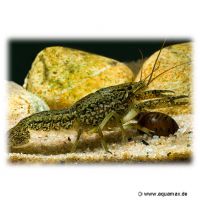Marbled Crayfish (Procambarus virginalis)
| Marbled Crayfish Procambarus virginalis | |
|---|---|
| Name | Marbled Crayfish |
| Name Lat. | Procambarus virginalis |
| Synonym | Procambarus fallax f. virginalis |
| Family | Freshwater Crayfish |
| Family lat. | Cambaridae |
| Order | Decapoda |
| Order lat. | Decapoda |
| Origin | North America |
| Habitat | Streams, ponds, swamps |
| Diet | Carrion, leaves, crayfish food |
| pH | 6.0-8.0 |
| Behavior | Aggressive |
| Keeping | Individual, pair, group |
| Care Level | Easy |
| Reproduction | Egg layer |
| Breeding | Simple |
| Life Span | 3-6 years |
| Protection | No |
| Metric Units | |
| Size | 6-12 cm |
| Temperature | 5-28 °C |
| Hardness | 5-15 °dH |
| Aquarium | 100 l |
| US Units | |
| Size | 2.4"-4.7" |
| Temperature | 41-82 °F |
| Hardness | 89-267 ppm |
| Aquarium | 25 gal |
Distribution and habitat
The marble crayfish originally come from southern North America. Due to reintroduction and their extraordinary adaptability, they can now be found in many regions of the world. They live in slow-flowing and stagnant waters, such as streams, swamps, ponds and irrigation ditches with dense vegetation.
Maintenance
They need a well-structured aquarium with roots, stones and robust plants, with hiding places (caves, crab tubes) and a moderate current. The substrate should be sand or gravel, partially covered with foliage (e.g. sea almond leaves, oak leaves).
No ammonia, ammonium and nitrite should be detectable in the aquarium water, the nitrate value should not exceed 100 mg/l. To ensure water quality and oxygen content, a filter and heater adapted to the size of the aquarium is required, as well as lighting for the species-appropriate day-night rhythm of the animals. When choosing the filter, special care should be taken to ensure that the animals cannot be sucked in.
Diet
They feed on animal organisms, carrion and dead plant material. They prefer live food, such as daphnia, artemia and fish, which is also accepted in frozen form, as well as foliage (e.g. oak, beech, maple, birch), food tablets, granulated and flake food. Occasionally, vegetable food in the form of spirulina, kelp or scalded leafy vegetables should be offered.
Regular and varied feeding promotes health and prevents deficiency symptoms. Unaccepted food must be removed after 2-3 hours.
Behaviour and compatibility
They behave aggressively within the species, but also towards other crayfish, therefore keeping several animals is only recommended in a much larger and richly structured tank. They can be socialized with shrimps, snails and smaller peaceful fish, but it is better to keep them in a species tank.
Basically, only mutually compatible animals with similar demands on water quality and water temperature may be socialized.
Reproduction and breeding
So far, only females are known from this species, which reproduce parthenogenetically, i.e. by self-fertilization. The eggs develop within three to six weeks, depending on water temperature and quality. The female carries the eggs (80-120 of them) on her pleopods (webbed feet) and supplies them with oxygen by movement (fanning). Dead or non-developing eggs are eaten by the female. The young hatch after about 4 weeks.
Important
Attention: According to "List of invasive alien species" (Implementing Regulation EU 2016/1141), since 3.8.2016 private keepers must ensure that this animal is kept under lock and key, does not reproduce, is not released into the environment or is not passed on to others.
They do not have special water quality requirements and can reside on land for extended periods of time (semiterrestrial). It is possible for an Everglades swamp crayfish to be missing a claw. This is usually females that have lost a claw during mating. The missing claw slowly grows back during subsequent molts.
As the foliage (e.g., sea almond or oak) rots, it promotes the development of microorganisms that provide a valuable secondary food source.
The well-being of the animals should be monitored regularly. Temperature should be checked daily, pH, hardness and nitrate levels at least every 14 days. Regular partial water changes are recommended, even when contaminant levels have not yet reached the upper limit. Sudden changes in water quality should be avoided. Newly introduced animals must be accustomed slowly to the water in the aquarium.
Further literature can be found in your pet store.
References
Text: Barbara Pachner; Image: www.aquamax.de
Source: LUKHAUP & PEKNY (2008): Süßwasserkrebse aus aller Welt, Dähne Verlag; ENGELMANN & LANGE (2011): Zootierhaltung - Tiere in menschlicher Obhut: Wirbellose, Verlag Harri Deutsch
